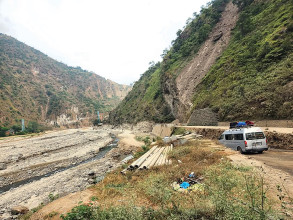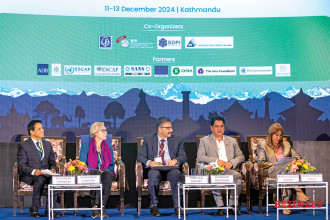
The government of India unveiled the full-fledged Union Budget of Fiscal Year 2024-25 on July 23 this year, almost five months behind the fiscal year calendar as an interim budget was presented on February 1 due to the Lok Sabha election (general election) in India. Finance Minister Nirmala Sitharaman presented her seventh union budget and this is the first budget of Prime Minister Narendra Modi’s third stint in India. Sitharaman is taking charge of the Ministry of Finance in the Modi government succeeding Arun Jaitley.
Apart from the direct grant to the government of Nepal as well as its neighbours and friendly countries, India’s budget could have various impacts on Nepal as India is the major trading partner of Nepal, according to Keshav Acharya, senior economist. Further, Nepal could have a trickle-down benefit from the economically rising India.
Grants increased for Nepal
The Union Budget has increased the grant allocation for Nepal and Sri Lanka. In FY 2024/25, the government allocated INR 700 crore (Rs 11.20 billion) in aid to Nepal, compared to INR 550 crore (Rs 8.80 billion) of last year. Similarly, for Sri Lanka, INR 245 crore has been allocated in this fiscal, compared to INR 150 crore from last year.
|
Grants allotted to India’s |
Total Loan |
NPL |
|
Country |
FY 2024/25 |
FY 2023/24 |
|
Bhutan |
INR 2,068 crore |
INR 2400 crore |
|
Bangladesh |
INR 120 crore |
INR 200 crore |
|
Nepal |
INR 700 crore |
INR 550 crore |
|
Sri Lanka |
INR 245 crore |
INR 150 crore |
|
Maldives |
INR 400 crore |
INR 770 crore |
|
Myanmar |
INR 250 crore |
INR 400 crore |
Lessons Nepal can learn from the Indian budget
India has aligned the ‘Economic Survey’ with the budget, as the issues highlighted by the survey are reflected in the budget. Nepal could learn from this practice and make the ‘Economic Survey’ more relevant, according to analysts.
“There is an in-depth analysis of emerging trends of the global economy and the Indian economy and their challenges based on research, and the issues have been addressed with policy measures by the budget, which can be considered as international best practice of evidence-based policy making.”
There are stark differences between the ‘Economic Survey’ and budget in Nepal. Economic Survey has taken a departure in India, which clearly underlines the need of attracting Chinese investment to lower the trade deficit with China. “This has challenged the ongoing reluctance of the political leadership to open up Chinese investment in India,” stated Nara Bahadur Thapa, Economist and former Executive Director of Nepal Rastra Bank. “India has been treating Chinese investment with the lens of security perspective. However, the ‘Economic Survey’ is seen to be more independent and research-based publication,” he added.
Employment link incentives
India’s budget 2024/25 has laid emphasis on jobs. As the government was formed with a fresh mandate of the people, the budget has envisioned to deploy around one crore interns in different companies including multinational companies (MNCs) in the next five years and the government will pay INR 15,000 to interns in three installments. It has envisioned to develop hostels for workers in different cities to facilitate them. The previous budgets had laid emphasis on production linked incentives that have been converted into employment link incentives that Nepal could learn from the Indian budget as we are facing a huge challenge of unemployment and people are migrating to seek job opportunities abroad, according to Acharya.
“In addition, the Union Budget of India has also laid emphasis on skilling of people. Currently, a large number of semi-skilled workforce from India are working in Nepal, and this trend could further escalate if Nepal does not enhance the skills of our people,” Acharya added.
The central India’s Union Budget 2024/25 has placed small and medium enterprises development at the centre. Considering that credit is the biggest challenge for SMEs development, the government has announced to provide credit guarantee to SMEs along with other incentives including ticket size of loans flowed to SMEs.
SMEs and credit guarantee
India’s Union Budget 2024/25 has placed small and medium enterprises development at the centre. “Considering that credit is the biggest challenge for SMEs development, the government has announced to provide credit guarantee to SMEs along with other incentives including ticket size of loans flowed to SMEs,” according to Thapa.
Likewise, the budget has announced a raft of programmes to promote green economy to combat with climate change challenges. Besides, the Indian budget has envisaged urban development as the key to leverage growth, create job opportunities and achieve Sustainable Development Goals (SDGs).
Enhancing favourable investment climate and next generation reforms
The Union Budget of India has been making big strides for improvement in the investment climate in a consistent manner. Taking reference of the World Bank Group’s Ease of Doing Business Report, which has been discontinued since several years, the Government of India has been transforming the investment climate based on the 10 major indicators – starting a business, dealing with construction permits, getting electricity, registering property, getting credit, protecting minority investors, paying taxes, trading across borders, enforcing contracts and resolving insolvency – by introducing various reform measures, schemes and programmes. In this context, Nepal could consistently work to improve the investment climate budget through other instruments, according to Thapa. “Besides, the budget has prioritised next generation reforms blending the doing business reform and SDGs as the broad parameters with focus on addressing the issues related to factors of production — land, labour, capital, entrepreneurship, technology and green economy.”
Convenient tax rates for middle class
The middle class is always the largest contributor of tax in developing nations due to their population and consumption capacity. India’s Union Budget has made adjustment in the income tax slabs. “Finance Minister Nirmala Sitharaman unveiled new income tax slabs under the revised tax regime. The Standard Deduction limit has been increased from INR 50,000 to INR 75,000,” according to Business Standard, India’s daily newspaper, “The slight enhancements in the standard deduction, the new tax regime slabs, and the increase in the tax-free Long-Term Capital Gains Tax (LTCG) threshold mean people will have marginally higher tax-free income.” Reportedly, the tax slab adjustment helps to save around INR 17,500.
Moreover, capital gains tax (CGT) has been increased to 12.5% from 10% for long-term investments and for short-term investment (within a year) the Indian government will slap 20% CGT from the earlier 15%. As the financial property and real estate is booming in India, raising CGT will be one of the credible tax sources in India.
Special Development Package for Andhra Pradesh and Bihar
Announcing a special development package, the budget allocated INR 15,000 crores for Andhra Pradesh’s development in FY 2024/25 and INR 26,000 crores for Bihar, to develop highways in Bihar, including the Patna-Purnia, Buxar-Bhagalpur, and Bodhgaya-Rajgir-Vaishali-Darbhanga Expressway, along with a new two-lane bridge over the Ganga River in Buxar. A 2,400 MW power plant and an industrial corridor node in Gaya has also been planned.
Earlier too, India had launched special development packages to minimise social tensions in Punjab and a similar approach was undertaken in the seven sister states of India — Arunachal Pradesh, Assam, Meghalaya, Manipur, Mizoram, Nagaland and Tripura. Prior to this, the interim budget had laid emphasis on housing, health, insurance and three major corridors – energy, minerals and cement corridor; a port connectivity corridor known as Rail Sagar; and a high-traffic density corridor like the major connectivity drives in the past under Bharatmala project. The three aforesaid corridors introduced in the budget are expected to leverage the Indian economy to achieve its goal.
The Government of India has envisioned to be the third biggest global economy in the next three years and ‘Vikashit Bharat’ (Developed India) by 2047 with an aim of growing to a $7-trillion economy.
Currently, the Purvodaya initiative, which has been benefiting Bihar will be expanded for all-round development of Bihar, Jharkhand, West Bengal, Odisha, and Andhra Pradesh, as mentioned in the Union Budget. As Nepal shares porous open border with Bihar, the rapid development of Bihar could benefit Nepal from the infrastructure across the border.
Learning from India, the government of Nepal can also address the development gap of the provinces, such as Karnali and Sudurpashchim province by expediting infrastructure development under a special development package, according to Thapa.






